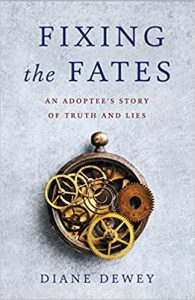Secrets in the Suitcase: Five Lessons from Writing my Memoir
 Visiting my mother at her home in Richmond, Virginia involves equal parts big hugs and, frequently, big worries. When, a year ago, I stepped out of the airport taxi, my first thought – usually, I hope she’s doing well – was of the draft manuscript of my memoir in my bag. Rather than set it down, I crooked my elbow to hold the carry-on from my Florida flight. The taller of the two of us, I wrapped my arms around my mother and breathed her soapy scent.
Visiting my mother at her home in Richmond, Virginia involves equal parts big hugs and, frequently, big worries. When, a year ago, I stepped out of the airport taxi, my first thought – usually, I hope she’s doing well – was of the draft manuscript of my memoir in my bag. Rather than set it down, I crooked my elbow to hold the carry-on from my Florida flight. The taller of the two of us, I wrapped my arms around my mother and breathed her soapy scent.
She was even tinier, more vulnerable than before, but spunky enough to point out that, finally, my hair looked okay.
This long-awaited approval of my appearance felt irrelevant, replaced by my more pressing need for privacy; that she not read the manuscript. My mother knew I’d been writing and taking courses in memoir, but nothing more. During this period while the book incubated, I protected my sensibilities from being interwoven with hers. I wanted my voice to tell the story of coming full circle; my adoption from a German orphanage six decades earlier, and the out of the blue appearance of my biological family in our lives.
In the upstairs guestroom, I swore as I cut open the sealed plastic casings around two Victorinox combination locks I’d bought at the airport.
Surreptitious dealings in my mother’s home carried me back to childhood, when my mother read my locked diary. As an adolescent, I was clearly not the only person who had a key. Her telltale page creases induced panic in me: I reread every passage, my palms clammy, wondering what she knew. Until one day when I decided that storing impressions in memory was more secure and I created fictitious dramas for my diary. Awaiting a confrontation with my mother, she only huffed off to the kitchen, unwilling to grant me acknowledgement that she’d either fallen for my ruse or seen through it.
Now, as a 62-year-old woman, I calculated the possibility that my 89-year-old mother would climb the stairs to rifle through my things. Tied with rubber bands, my book was in printer paper form, an entire ream of it, loaded with corrections to proof, but also stories about her. I snapped the locks shut, feeling sheepish, and hoped I’d remember the combinations.
Downstairs, after pleasantries and a cup of tea, my mother leaned back in her mint green ultra-suede recliner and asked, “Under what name are you writing?”
“My own,” I countered, smiling, relieved that my last name was that of my ex. The answer seemed to appease her, and we returned to conversation about family news. But as my mother flipped through television channels after dinner, my mind swirled on the content of my memoir and how it would sound to her. If we were to fast-forward another ten months, I would find that my worries were completely misdirected. To the contrary, I was to learn a lot.
***
Lesson number one: Do not think you can anticipate the reactions of those around you.
Lesson number two: If you’re depicting real life characters, as I was, write their true names into the scenes so that the interactions have their original vitality. This brings a sense of immediacy to your work and fresh energy to you as a writer. Besides, if you so choose, you can change the names later using a word search function. Just don’t depend on proofreading to do it.
Lesson number three: Stay in the moment of what you’re writing. While it’s good to gain perspective on life events so that as a memoir writer, you’re sharing reflections rather than blabbering into the reader’s ear, it’s essential to keep processing as you’re writing. Nothing is more boring than telescoping so far back that it sounds as though you’ve written about someone else, without feeling. Keep your reactions immediate, especially in dialogue.
Lesson number four: It may seem contradictory but try to work out your family dynamics and issues as best you can before you start to write. The written word is no substitute for resolution. Your heartfelt emotion is best delivered in person, so the other person has the chance to react. Otherwise, reading text renders the other party passive with no outlet and may be extremely wounding or even unjust; this is, after all, your version of events. Your book is a form of communication, not a stand-in for doing your homework.
Lesson number five: While zeroing in on personal idiosyncrasies that give your character personality, remember to zoom out and contextualize the person in terms of their own background and experience. If you don’t enter the psychic space of your character, you haven’t done your job as a writer. You’ve only written your own point of view. And since writing memoir creates an evolution in the writer and reader, let it begin and end with compassion.
***
Ten months after I’d visited my mother the year before my memoir was to be published, she sat back in a different recliner, a chemotherapy tube hooked up to her shoulder. My usually chatty mom closed her eyes a moment and sighed. I leaned toward her. When she roused, she said, “I want to live. I want to see my niece’s grand baby become a little girl.”
“Oh, mom, that’s great,” I said But she interrupted.
“And I want to live so that I can see you grow.”
I was bowled over with relief and filled with warmth. Surrounded by the antiseptic smells and calm efficiency of the chemotherapy wing, something inside me burst wide open. While I thought I knew my mother, that past didn’t matter anymore. I hoped the stories I’d written about, lodged in history too, would no longer have their once immense hold over us either. It was a life-affirming moment, when my mother and I entered what could be called a state of grace, or even love.
—
DIANE DEWEY: Diane holds her BA from Villanova University, the Honors Program in Liberal Arts. She later completed a certificate program from The Art Institute of Philadelphia, working for the Solomon. R. Guggenheim Museum and the National Academy, before founding her own art appraisal firm. Diane earned a Master of Science in Mental Health Counseling from Capella University in 2015. She lives in St. Petersburg, Florida and near Schaffhausen, Switzerland with her husband and their rescue dog. Fixing the Fates is her first book. For more information about Diane, visit her website: http://dianedewey.com/
FIXING THE FATES
 The secrets, lies, and layers of deception about Diane Dewey’s origins were meant for her protection―but eventually, they imploded. Living with her family in suburban Philadelphia, Diane had grown up knowing she was born in Stuttgart and adopted at age one from an orphanage. She’d been told her biological parents were dead. Then, in 2002, when she was forty-seven years old, Diane got a letter from Switzerland: her biological father, Otto, wanted to bring her into his life. With that, her world shifted on its axis.
The secrets, lies, and layers of deception about Diane Dewey’s origins were meant for her protection―but eventually, they imploded. Living with her family in suburban Philadelphia, Diane had grown up knowing she was born in Stuttgart and adopted at age one from an orphanage. She’d been told her biological parents were dead. Then, in 2002, when she was forty-seven years old, Diane got a letter from Switzerland: her biological father, Otto, wanted to bring her into his life. With that, her world shifted on its axis.
In the months that ensued, everybody had a different story to tell about Diane’s origins, including Otto when they met in New York City. She struggled to understand what was at stake with the lies. Like a private eye, she sifted through competing versions of the truth only to find that, having traveled throughout Europe and back, identity is a state of mind. As more information surfaced, the myths gave way to a certain elusive peace; Diane discovered a tribe in her mother’s family, found a Swiss husband, gained a voice, and, for the first time, began to trust in the intuition that had nudged her all along. One-part forensic investigation, one-part self-discovery, Fixing the Fates is a story about seeing behind artifice and living one’s truth.
Category: How To and Tips, On Writing































Where are you in FL. I’m in Boca Raton.
Enjoyed your post. It brought back many memories. My first book, a novel will be out next year and I am now writing a memoir.